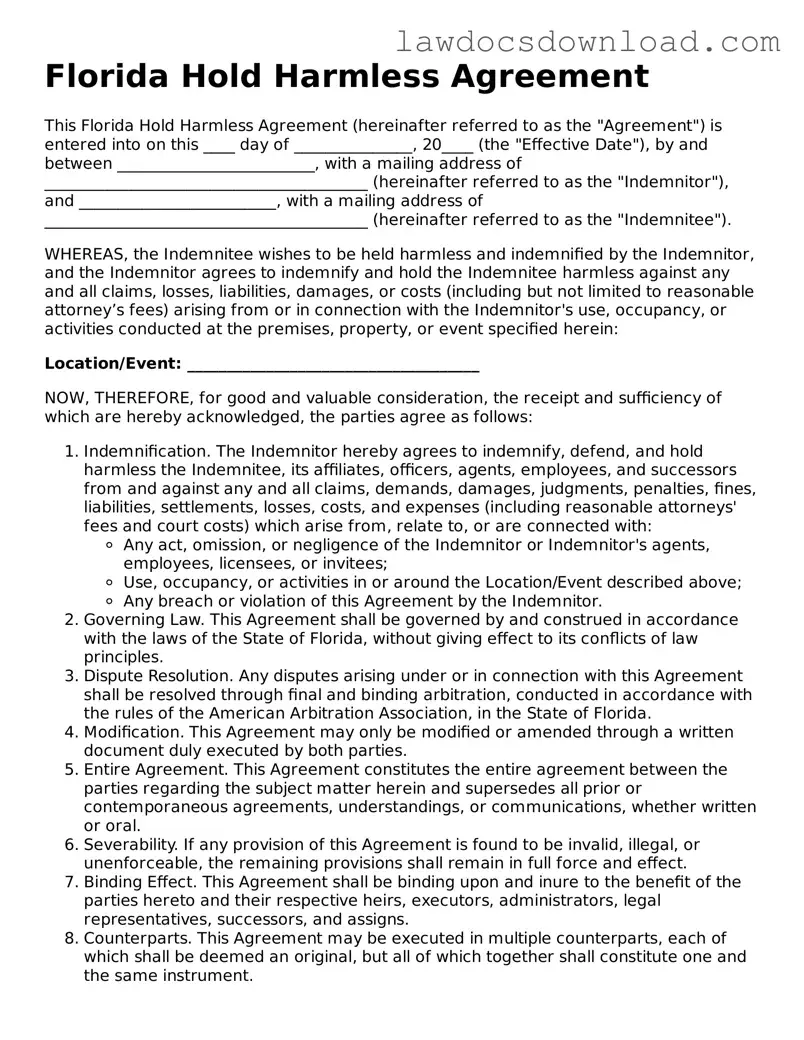Florida Hold Harmless Agreement
This Florida Hold Harmless Agreement (hereinafter referred to as the "Agreement") is entered into on this ____ day of _______________, 20____ (the "Effective Date"), by and between _________________________, with a mailing address of _________________________________________ (hereinafter referred to as the "Indemnitor"), and _________________________, with a mailing address of _________________________________________ (hereinafter referred to as the "Indemnitee").
WHEREAS, the Indemnitee wishes to be held harmless and indemnified by the Indemnitor, and the Indemnitor agrees to indemnify and hold the Indemnitee harmless against any and all claims, losses, liabilities, damages, or costs (including but not limited to reasonable attorney’s fees) arising from or in connection with the Indemnitor's use, occupancy, or activities conducted at the premises, property, or event specified herein:
Location/Event: _____________________________________
NOW, THEREFORE, for good and valuable consideration, the receipt and sufficiency of which are hereby acknowledged, the parties agree as follows:
- Indemnification. The Indemnitor hereby agrees to indemnify, defend, and hold harmless the Indemnitee, its affiliates, officers, agents, employees, and successors from and against any and all claims, demands, damages, judgments, penalties, fines, liabilities, settlements, losses, costs, and expenses (including reasonable attorneys' fees and court costs) which arise from, relate to, or are connected with:
- Any act, omission, or negligence of the Indemnitor or Indemnitor's agents, employees, licensees, or invitees;
- Use, occupancy, or activities in or around the Location/Event described above;
- Any breach or violation of this Agreement by the Indemnitor.
- Governing Law. This Agreement shall be governed by and construed in accordance with the laws of the State of Florida, without giving effect to its conflicts of law principles.
- Dispute Resolution. Any disputes arising under or in connection with this Agreement shall be resolved through final and binding arbitration, conducted in accordance with the rules of the American Arbitration Association, in the State of Florida.
- Modification. This Agreement may only be modified or amended through a written document duly executed by both parties.
- Entire Agreement. This Agreement constitutes the entire agreement between the parties regarding the subject matter herein and supersedes all prior or contemporaneous agreements, understandings, or communications, whether written or oral.
- Severability. If any provision of this Agreement is found to be invalid, illegal, or unenforceable, the remaining provisions shall remain in full force and effect.
- Binding Effect. This Agreement shall be binding upon and inure to the benefit of the parties hereto and their respective heirs, executors, administrators, legal representatives, successors, and assigns.
- Counterparts. This Agreement may be executed in multiple counterparts, each of which shall be deemed an original, but all of which together shall constitute one and the same instrument.
IN WITNESS WHEREOF, the parties have executed this Florida Hold Harmless Agreement as of the Effective Date first above written.
Indemnitor: ___________________________
Signature: ______________________________
Date: ___________________________________
Indemnitee: ___________________________
Signature: ______________________________
Date: ___________________________________
